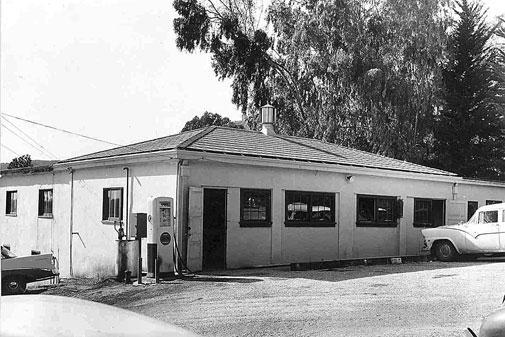Westmont Magazine A Modified History of an Old Garage
When Westmont purchased its Santa Barbara campus in 1945, the former estate included some smaller buildings as well as the stately mansion that became Kerrwood Hall. One of these, a four-car garage, served as the home of the chemistry department, complete with a classroom, two laboratories and storage space. Two years later the college doubled the size of this structure by constructing a physics lab at the rear of the building. In 1955, the art department and women’s physical education program moved in with the addition of a shed on the west side of the building containing six showers, a dressing room and individual baskets. The gasoline pump remained outside for years, and faculty and staff purchased discounted fuel there.
The chemistry faculty operated with limited resources in the early years of the college. John Vosbigian, who taught from 1950-1955, remembers the challenges. “We would purchase equipment in small increments since money was in short supply. I recruited my lab assistants and stock clerk from my first Chemistry 1 class. Periodically I would visit government surplus centers and purchase supplies.”
Meanwhile, modifications to the building continued. In 1961, the college converted the chemistry classroom into a laboratory. The physical education program settled in the Murchison complex in the 1960s and art went first to Reynolds Hall and later to the Westmont Art Center.
The physics department welcomed more office, classroom and laboratory space when the chemistry department moved to Mericos H. Whittier Science Building in 1984. Michael Sommermann, professor of physics, recalls when a bottle of picric acid was discovered in the basement a year or so after chemistry moved. Usually it’s not a dangerous chemical, but it had dried and crystallized and could have exploded at any time. “The building was evacuated, a perimeter established, and the Santa Barbara bomb squad moved in,” Sommermann says. “The item was carefully removed and then unceremoniously blown up in a huge blast on one of the athletic fields — just another day at my office.”
Outside the entrance, physics students watched Professor Ken Kihlstrom walk on hot coals and lie on a bed of nails every year to bravely illustrate the laws of physics.
The building also housed the Westmont College Cosmic Muon Detector Array (CMDA), which 10 students under the supervision of Professor Warren Rogers built. They had helped develop the Modular Neutron Array (MoNA) for the National Superconducting Cyclotron Laboratory (NSCL) at Michigan State University through a project funded by the National Science Foundation, and they based the CMDA on MoNA. The instrument allowed Westmont students to do graduate-level research.
The physics building survived potentially explosive picric acid but not the Tea Fire. The November 2008 blaze destroyed the CMDA and the labs and offices of the physics department, incinerating much valuable research and equipment. While the physics professors deeply regret the loss of their work and facilities, they look forward to moving into exciting new space in Winter Hall for Science and Mathematics when it opens in spring 2011.

